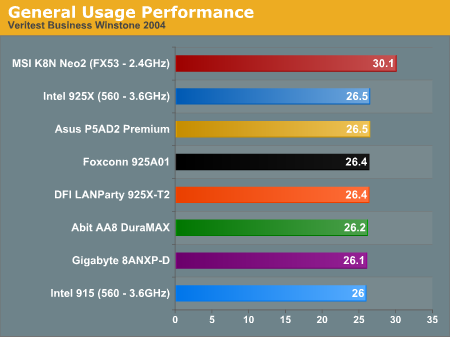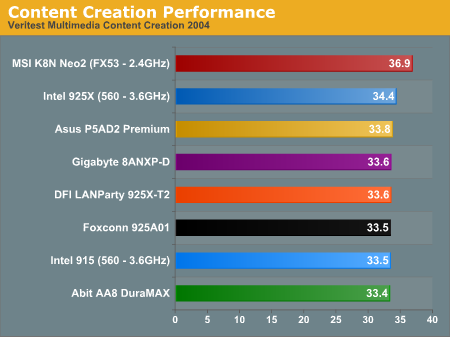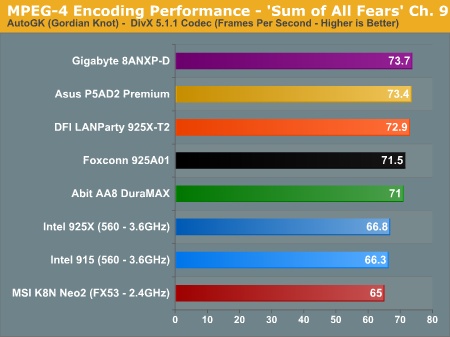Intel 925X Roundup: Creative Engineering 101
by Wesley Fink on August 12, 2004 12:05 AM EST- Posted in
- Motherboards
General Performance and Encoding



With all motherboards based on the same Intel 925X chipset and tested with the same CPU, it is not a surprise that the test results for Multimedia Content Creation Winstone and Business Winstone are tightly clustered. You may be more interested in comparisons to the Intel 915 chipset board, which is just a bit slower, and the Athlon 64 FX53, which dominates these two general performance areas.
The performance of the LGA 775 925X boards in the new AutoGK 2-pass Media Encoding benchmark was pretty much what was expected. Intel has dominated media encoding in the past, but results are now close comparing the top 925X boards to a top 939 Athlon 64 board. With these top-line 925X boards combined with the top 3.6 Prescott CPU and DDR2 running at 3-3-3 instead of the slower 4-4-4 timings, Intel retains a small lead in Media encoding.
We expected Intel to retain their lead in media encoding due to our logical choice of DivX 5.1.1 as the encoding codec. This codec fully exploits the SSE3 features of the Intel chipset and generally favors the Intel processors. The DVD2AVI engine at the heart of AutoGK, on the other hand, generally favors AMD processors. It appears that you can really show whatever you wish in encoding these days, depending on the Encoding program and codec used. Anand did extensive research on media encoding and chose the new AutoGK/DivX 5.1.1. as our new standard due to the fair, balanced and respected results obtained with this combination.










30 Comments
View All Comments
johnsonx - Thursday, August 12, 2004 - link
What is it with you people griping about CPU choices? This is a review of current top-end 925X boards, not a CPU review! The FX-53 scores are there only for a point of reference. Added to that, Wesley's point is VERY valid: the 560 and FX-53 ARE the top CPU's from each camp.If you really want to know how a 3800+ would perform, refer to past Socket-939 reviews, or just mentally subtract about 3% or so.
STOP WHINING!
Wesley Fink - Thursday, August 12, 2004 - link
#17 - Since we were trying to determine the maximum overclocking ability of the boards tested, we used a 3.6 ES LGA 775 Prescott at a 14 multiplier (2.8Ghz). The 14x280 is close to 3.9GHz speed. We also checked with a retail 540 (3.2GHz) and reached 250FSB (4.0GHz) at 1.45V.These results lead us to believe that many 775 Prescotts will top out at 3.9 to 4.0GHz on boards that will support those overclock levels. That means that there are likely some 2.8 Prescotts out there that can reach 280FSB.
As always, overclocking is variable, and you need a really great power supply and decent cooling to support the power requirements at these kinds of overclocks.
Carfax - Thursday, August 12, 2004 - link
Wesley, is it possible to do a review of Prescott which focuses on the upcoming 1ghz FSB? I've heard that Prescott scales better than N.W with a higher FSB and greater clockspeed..To do the review correctly, you'd need an engineering sample with an unlocked multiplier, so you can see the benefit of the increased FSB, without raising the clockspeed.
I think Prescott would do pretty well on 1066FSB and with fast DDR2 memory..
danidentity - Thursday, August 12, 2004 - link
Wes,When you say you hit 280 FSB with the Asus P5AD2, was that with a retail chip, multiplier locked? Or were you using an ES chip. If you were using a retail, that is an absolutely insane overclock.
danidentity - Thursday, August 12, 2004 - link
>> Better than comparing a 3500+ to a 3.6F anyway :PHow would a 3500+ compare with a Intel 3.6? Could it hang? :)
RyanVM - Thursday, August 12, 2004 - link
I have no problem with the 3.6E and FX53 being shown together since both platforms will end up costing about the same (factoring in CPU, mobo, and memory costs). Prices fluctuate, yes, but both companies (OK, mainly AMD) tend to adjust prices to stay in line with performance levels (if Intel drops the 3.6E price, I'd put money on AMD dropping prices at the high end within a day or two).Better than comparing a 3500+ to a 3.6F anyway :P
Creig - Thursday, August 12, 2004 - link
#12/#13 Given the way pricing can fluctuate, it would be futile to compare Intel $$$ to AMD $$$. A couple of days after the article was published, pricing could change to make the monetary comparison useless and therefore misleading.I think they're doing it the correct way. It's up to the end user to find his/her best balance between performance and price.
mjz5 - Thursday, August 12, 2004 - link
man, i should of read #12 first before posting it.. why not have an edit button?anyhow, u all know what i'm saying!!!
mjz5 - Thursday, August 12, 2004 - link
the way i see it is that CPUs should be compared by price. If an AMD FX-53 cost as much as a Celeron 2.4 GHz, why not compare the two? If someone is going to looking at these products because they cost X dollars, they aren't interested in seeing that an Intel CPU that cost (X*2) may or not surpass it the competitor at only X dollars.Wesley Fink - Thursday, August 12, 2004 - link
#9 & #10 - Corrected